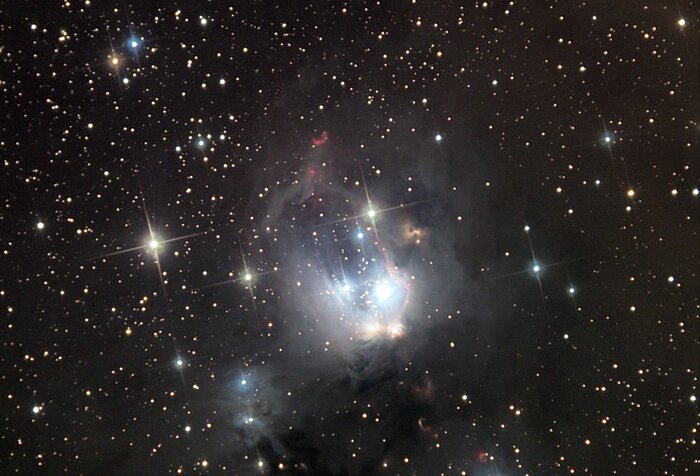NGC 7129
NGC 7129 is a star-forming region that contains many interesting features. Astronomers estimate that many of the bright stars shown here are younger than 1 million years old! These "baby" stars are very energetic and emit copious amounts of radiation that break apart (photodissociate) clouds of natal gas that surrounds them. One edge of this newly formed cavity glows pink due to the excited hydrogen gas in the region. In addition, a small number of very red structures indicate regions where new stars are forming (but are not yet visible directly). These regions are often outflows of gas called Herbig Haro (HH) objects. (The crescent shaped object near the top of the nebula is HH103). Finally, energetic regions like this can often produce molecular masers. A maser (like a laser) is a coherent signal of light, generally at microwave wavelengths. In this case the molecules in this gas region are excited (vibrate) by high-energy photons and re-emit light (microwaves) to us in a preferential manner. The fascinating thing is that the molecules in question are quite important (to us): H2O (water!).
This image was taken as part of Advanced Observing Program (AOP) program at Kitt Peak Visitor Center during 2014.
Credit:KPNO/NOIRLab/NSF/AURA/George Seitz/Adam Block
About the Image
| Id: | noao-n7129block |
| Type: | Observation |
| Release date: | June 11, 2014, 6 a.m. |
| Size: | 1425 x 969 px |
About the Object
Wallpapers
Coordinates
| Position (RA): | 21 42 11.71 |
| Position (Dec): | 66° 6' 49.37" |
| Field of view: | 18.34 x 12.50 arcminutes |
| Orientation: | North is 148.4° left of vertical |
Colors & filters
| Band | Wave-length | Tele-scope |
|---|---|---|
| Optical B | 438 nm | Visitor Center 0.5-meter Telescope Other CCD |
| Optical G | 475 nm | Visitor Center 0.5-meter Telescope Other CCD |
| Optical R | 625 nm | Visitor Center 0.5-meter Telescope Other CCD |
| Optical Broad Band | 555 nm | Visitor Center 0.5-meter Telescope Other CCD |

